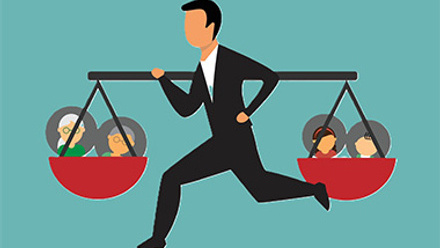Why women are more at risk of burnout and what employers can do to close this gap
The pandemic hugely affected how and where employees work, while introducing new stressors, increasing risk of exhaustion, burnout and struggling to balance home and work demands.
Studies such as the McKinsey and LeanIn.Org’s Women in the Workplace report reveal a growing gender gap when it comes to workplace burnout.
The mental wellbeing platform ‘87%’, reported in HR News that women are 23% more likely than men to struggle with poor work-life balance,and 45% more likely to suffer from work stress. Less than half of women rated their current job satisfaction, motivation, and productivity as ‘good’ post-pandemic.
Burnout is now becoming so prevalent that one in three women have considered downshifting or leaving the workforce altogether during the past year.
Why women are even more at risk
Childcare demands at home soared during the pandemic, with women doing three times more unpaid childcare than men.
As reported in the Independent, research from University College London shows that women who live with men continue to do most of the housework.
Women are more likely to carry the burden of ‘mental load’ – the invisible work involved in managing a household and/or family eg planning appointments and food shopping.
The ‘always-on’ culture created by remote working leaves less time for self-care. Being in a constant state of stress can cause physical symptoms such as fatigue, sleep disturbance and headaches, as well as mental health issues like anxiety and depression.
Long-term stress can increase susceptibility health issues like obesity, heart attacks and stroke – especially when we turn to unhelpful coping strategies such as excessive drinking.
How does this effect women in the workplace?
Ill health negatively affects work performance and productivity, which in turn leads to further stress, and often overworking to compensate. These vicious cycles can drive ‘leaveism’ and ‘presenteeism’, which exacerbate problems even further.
Despite their own increasing levels of burnout, women are much more likely than men to support others taking action to fight it, for example, by managing the workloads of their teams and supporting diversity equity and inclusion efforts.
According to Nuffield Health’s Healthier Nation Index, over the last year 15% of UK adults did no exercise at all, but those who exercised for as little as up to 15 minutes a week reported better mental and physical health. Some 40% of women cited embarrassment as a barrier to exercise, compared with 29% of men.
Burnout may present itself as a measurable decline in work standards, as well as changes in behaviour, such as irritability, low mood, tiredness, and an inability to concentrate.
How leaders can support women
To prevent losing female talent, managers must recognise the signs of burnout and feel confident in offering support to individuals. Burnt out employees are often reluctant to speak about their situation.
• Equip staff with the skills to confidently hold conversations about mental health. This builds a positive culture around mental health, where conversations are welcome and expected. Not only are individuals capable of supporting others but they are more likely to seek support for themselves at the earliest signs of difficulty – before they become burnt out.
• Leaders need to be aware of equality imbalances and how to remove these barriers and biases, which prevent women from being recognised and promoted. Provide training, support and mentoring opportunities and educate employees, at all levels, about unconscious biases. Ensure there is company-wide awareness of self-promotion opportunities.
• Employers should direct staff towards the emotional wellbeing support available. This may include employee assistance programmes or cognitive behavioural therapy, which can help people understand and break unhelpful thinking patterns, reframe unhelpful thoughts and cope in new and uncertain situations.
Why flexibility is important
Flexibility needs to be offered to ensure employers are as inclusive as possible. Some companies offer fully built out ‘flex time’ policies; other perks include part-time hours, shared parental leave and telecommuting roles.
As people adopt flexible working patterns, such as working into the evening to accommodate the morning school run – employees may worry about the need to be ‘always on’. Here it’s important to reiterate that employees shouldn’t feel pressured to reply to emails out of hours and encourage them to switch devices off after work. Remind everyone that perfection is not expected.
Stronger attempts at maintaining a level playing field in the workplace and showing you support individual, physical and emotional needs will reduce burnout and help female employees to thrive.
Supplied by REBA Associate Member, Nuffield Health
Nuffield Health are the UK's largest healthcare charity & the market leader in corporate healthcare.








